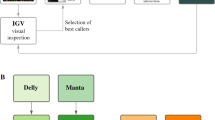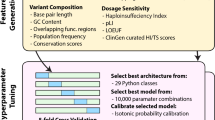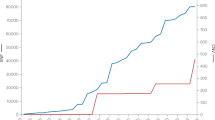Abstract
Copy number variants (CNVs) account for the majority of human genomic diversity in terms of base coverage. Here, we have developed and applied a new method to combine high-resolution array comparative genomic hybridization (CGH) data with whole-genome DNA sequencing data to obtain a comprehensive catalog of common CNVs in Asian individuals. The genomes of 30 individuals from three Asian populations (Korean, Chinese and Japanese) were interrogated with an ultra-high-resolution array CGH platform containing 24 million probes. Whole-genome sequencing data from a reference genome (NA10851, with 28.3× coverage) and two Asian genomes (AK1, with 27.8× coverage and AK2, with 32.0× coverage) were used to transform the relative copy number information obtained from array CGH experiments into absolute copy number values. We discovered 5,177 CNVs, of which 3,547 were putative Asian-specific CNVs. These common CNVs in Asian populations will be a useful resource for subsequent genetic studies in these populations, and the new method of calling absolute CNVs will be essential for applying CNV data to personalized medicine.
This is a preview of subscription content, access via your institution
Access options
Subscribe to this journal
Receive 12 print issues and online access
$259.00 per year
only $21.58 per issue
Buy this article
- Purchase on SpringerLink
- Instant access to full article PDF
Prices may be subject to local taxes which are calculated during checkout





Similar content being viewed by others
References
Iafrate, A.J. et al. Detection of large-scale variation in the human genome. Nat. Genet. 36, 949–951 (2004).
Conrad, D.F. et al. Origins and functional impact of copy number variation in the human genome. Nature advance online publication, doi:10.1038/nature08516 (7 October 2009).
Perry, G.H. et al. The fine-scale and complex architecture of human copy-number variation. Am. J. Hum. Genet. 82, 685–695 (2008).
Redon, R. et al. Global variation in copy number in the human genome. Nature 444, 444–454 (2006).
Kim, J.I. et al. A highly annotated whole-genome sequence of a Korean individual. Nature 460, 1011–1015 (2009).
Conrad, D.F., Andrews, T.D., Carter, N.P., Hurles, M.E. & Pritchard, J.K. A high-resolution survey of deletion polymorphism in the human genome. Nat. Genet. 38, 75–81 (2006).
Lindner, I. et al. Putative association between a new polymorphism in exon 3 (Arg109Cys) of the pancreatic colipase gene and type 2 diabetes mellitus in two independent Caucasian study populations. Mol. Nutr. Food Res. 49, 972–976 (2005).
Shiffman, D. et al. Analysis of 17,576 potentially functional SNPs in three case-control studies of myocardial infarction. PLoS One 3, e2895 (2008).
Cunninghame Graham, D.S. et al. Association of LY9 in UK and Canadian SLE families. Genes Immun. 9, 93–102 (2008).
Larson, M.G. et al. Framingham Heart Study 100K project: genome-wide associations for cardiovascular disease outcomes. BMC Med. Genet. 8 Suppl 1, S5 (2007).
Samuels, Y. et al. High frequency of mutations of the PIK3CA gene in human cancers. Science 304, 554 (2004).
Lee, J.W. et al. PIK3CA gene is frequently mutated in breast carcinomas and hepatocellular carcinomas. Oncogene 24, 1477–1480 (2005).
Colin, Y. et al. Genetic basis of the RhD-positive and RhD-negative blood group polymorphism as determined by Southern analysis. Blood 78, 2747–2752 (1991).
Wang, Y.H. et al. Detection of RhD(el) in RhD-negative persons in clinical laboratory. J. Lab. Clin. Med. 146, 321–325 (2005).
Kidd, J.M. et al. Mapping and sequencing of structural variation from eight human genomes. Nature 453, 56–64 (2008).
Korbel, J.O. et al. Paired-end mapping reveals extensive structural variation in the human genome. Science 318, 420–426 (2007).
Lohmueller, K.E. et al. Proportionally more deleterious genetic variation in European than in African populations. Nature 451, 994–997 (2008).
Tuzun, E. et al. Fine-scale structural variation of the human genome. Nat. Genet. 37, 727–732 (2005).
Aitman, T.J. et al. Copy number polymorphism in Fcgr3 predisposes to glomerulonephritis in rats and humans. Nature 439, 851–855 (2006).
Burchard, E.G. et al. The importance of race and ethnic background in biomedical research and clinical practice. N. Engl. J. Med. 348, 1170–1175 (2003).
Horowitz, R.E. Gastric cancer in Japan. N. Engl. J. Med. 359, 2393–2394, author reply 2394–2395 (2008).
Hossain, P., Kawar, B. & El Nahas, M. Obesity and diabetes in the developing world—a growing challenge. N. Engl. J. Med. 356, 213–215 (2007).
Jee, S.H. et al. Body-mass index and mortality in Korean men and women. N. Engl. J. Med. 355, 779–787 (2006).
Acknowledgements
We acknowledge R. Govindaraju for editing this manuscript. This work has been supported in part by Macrogen Inc. (MG2009009), Psoma Therapeutics Inc., the Korean Ministry of Education, Science and Technology (grant M10305030000), Green Cross Therapeutics (0411-20080023), the Department of Pathology at Brigham and Women's Hospital (to C.L.) and a US National Institutes of HealthGrant (HG004221 to C.L.).
Author information
Authors and Affiliations
Contributions
J.-S.S. and C.L. planned and managed the project. H.P., J.-I.K., Y.S.J., O.G., R.E.M., Y.J.Y., J.-Y.S., J.-S.H., W.C., G.-R.H. and K.D. executed and analyzed aCGH experiments. J.-I.K., Y.S.J., S.K., D.H., H.-J.K. and D.H. executed sequencing of the genome and analyzed sequence data. D.S., S.L., M.Y., Y.W.C., HyeRan Kim, S.J.Y., K.-S.Y. and Hyungtae Kim performed validation experiments; M.E.H., S.W.S., N.P.C. and C.T.-S. assisted in data analyses; J.-S.S., C.L., H.P., J.-I.K., Y.S.J. and H.P.K. wrote the manuscript.
Corresponding authors
Ethics declarations
Competing interests
The authors declare no competing financial interests.
Supplementary information
Supplementary Text and Figures
Supplementary Figures 1–11, Supplementary Tables 1–12 and Supplementary Note (PDF 2730 kb)
Supplementary Figure 3
Read-depth information for 721 validated CNVs in AK1 using data for AK1 and NA10851 (PDF 23684 kb)
Supplementary Table 3
Absolute CNVs of 30 Asians (XLS 2289 kb)
Supplementary Table 5
List of primers for qPCR and breakpoint sequencing experiments (XLS 36 kb)
Supplementary Table 7
List of 5,177 CNVE identified in the 30 Asians studied (XLS 1468 kb)
Supplementary Table 8
List of OMIM genes in identified CNVs (XLS 348 kb)
Supplementary Table 9
List of microRNAs overlapping the personal CNVs identified in the study (XLS 36 kb)
Supplementary Table 10
List of fusion gene overlapping the personal CNVs identified in this study (XLS 50 kb)
Supplementary Table 11
Modified PANTHER ontology analysis (XLS 116 kb)
Rights and permissions
About this article
Cite this article
Park, H., Kim, JI., Ju, Y. et al. Discovery of common Asian copy number variants using integrated high-resolution array CGH and massively parallel DNA sequencing. Nat Genet 42, 400–405 (2010). https://doi.org/10.1038/ng.555
Received:
Accepted:
Published:
Issue date:
DOI: https://doi.org/10.1038/ng.555
This article is cited by
-
Ethnic and functional differentiation of copy number polymorphisms in Tunisian and HapMap population unveils insights on genome organizational plasticity
Scientific Reports (2024)
-
Nexus between genome-wide copy number variations and autism spectrum disorder in Northeast Han Chinese population
BMC Psychiatry (2023)
-
Science and philosophy of Korea traditional foods (K-food)
Journal of Ethnic Foods (2023)
-
Effects of Long-Term In Vitro Expansion on Genetic Stability and Tumor Formation Capacity of Stem Cells
Stem Cell Reviews and Reports (2022)
-
Fryns type mesomelic dysplasia of the upper limbs caused by inverted duplications of the HOXD gene cluster
European Journal of Human Genetics (2020)



